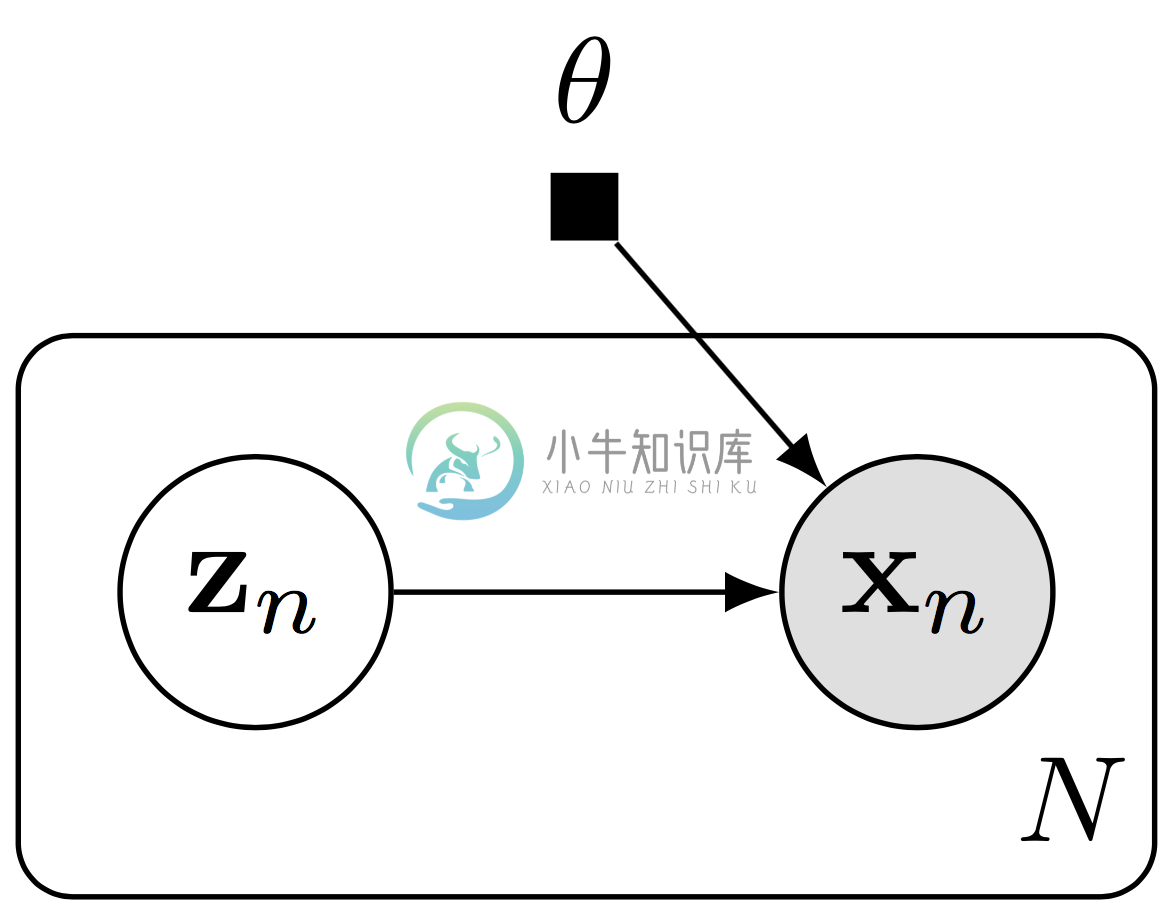Probabilistic Decoder
Probabilistic Decoder
A probabilistic decoder is a reinterpretation of model likelihoods based on coding theory. It is a distribution $(p(\mathbf{x}_n\mid \mathbf{z}_n))$ over each value $(\mathbf{x}_n\in\mathbb{R}^D)$ given a code $(\mathbf{z}_n)$. The latent variables $(\mathbf{z}_n)$ are interpreted as the hidden representation, or code, of the value $(\mathbf{x}_n)$. The decoder is probabilistic because its generated VALUES (NULL, Hinton, Neal, & Zemel, 1995).

Graphical model of a probabilistic decoder, with model parameters $(\theta)$.
For real-valued data, the randomness in the decoder is given by a multivariate Gaussian \[\begin{aligned} p(\mathbf{x}_n\mid\mathbf{z}_n) &= \text{Normal}(\mathbf{x}_n\mid [\mu,\sigma^2]=\mathrm{NN}(\mathbf{z}_n; \mathbf{\theta})),\end{aligned}\] where the probabilistic decoder is parameterized by a neural network $(\mathrm{NN})$ taking the code $(\mathbf{z}_n)$ as input.
For binary data, the randomness in the decoder is given by a Bernoulli \[\begin{aligned} p(\mathbf{x}_n\mid\mathbf{z}_n) &= \text{Bernoulli}(\mathbf{x}_n\mid p=\mathrm{NN}(\mathbf{z}_n; \mathbf{\theta})).\end{aligned}\] Probabilistic decoders are typically used alongside a standard normal prior over the code \[\begin{aligned} p(\mathbf{z}) &= \text{Normal}(\mathbf{z} \mid \mathbf{0}, \mathbf{I}).\end{aligned}\]
Let’s build the model in Edward using Keras as an easy way to build neural networks. Here we use a probabilistic decoder to model binarized 28 x 28 pixel images from MNIST.
from edward.models import Bernoulli, Normal
from keras.layers import Dense
z = Normal(loc=tf.zeros([N, d]), scale=tf.ones([N, d]))
hidden = Dense(256, activation='relu')(z)
x = Bernoulli(logits=Dense(28 * 28)(hidden))It starts with a $(d)$-dimensional standard normal prior, one for each data point. Then it applies a layer of 256 hidden units with relu nonlinearity. The output layer is $(28\cdot 28)$ units without a nonlinearity. This output parameterizes the Bernoulli’s logits. Logits are a more numerically stable parameterization than probabilities constrained from 0 and 1.
An example script using this model can be found at examples/vae.py in the Github repository. An example with a convolutional architecture can be found at examples/vae_convolutional_prettytensor.py in the Github repository.
Footnotes
The neural network which parameterizes the probabilistic decoder is also known as a generative network. It is in analogy to an inference network, which can parameterize a variational model used for inference, interpreted as a probabilistic encoder.
Traditionally, a probabilistic encoder is the most common choice of inference. This lead to the coinage of the model-inference combination known as the variational auto-encoder (Kingma & Welling, 2014), which is a probabilistic extension of auto-encoders. We recommend against this terminology, in favor of making explicit the separation of model and inference. That is, probabilistic decoders are a general class of models that can be used without an encoder. Variational inference is not necessary to infer probabilistic decoders, and variational inference can also be done without an inference network.
References
Dayan, P., Hinton, G. E., Neal, R. M., & Zemel, R. S. (1995). The Helmholtz machine. Neural Computation, 7(5), 889–904.
Kingma, D., & Welling, M. (2014). Auto-encoding variational Bayes. In International conference on learning representations.

